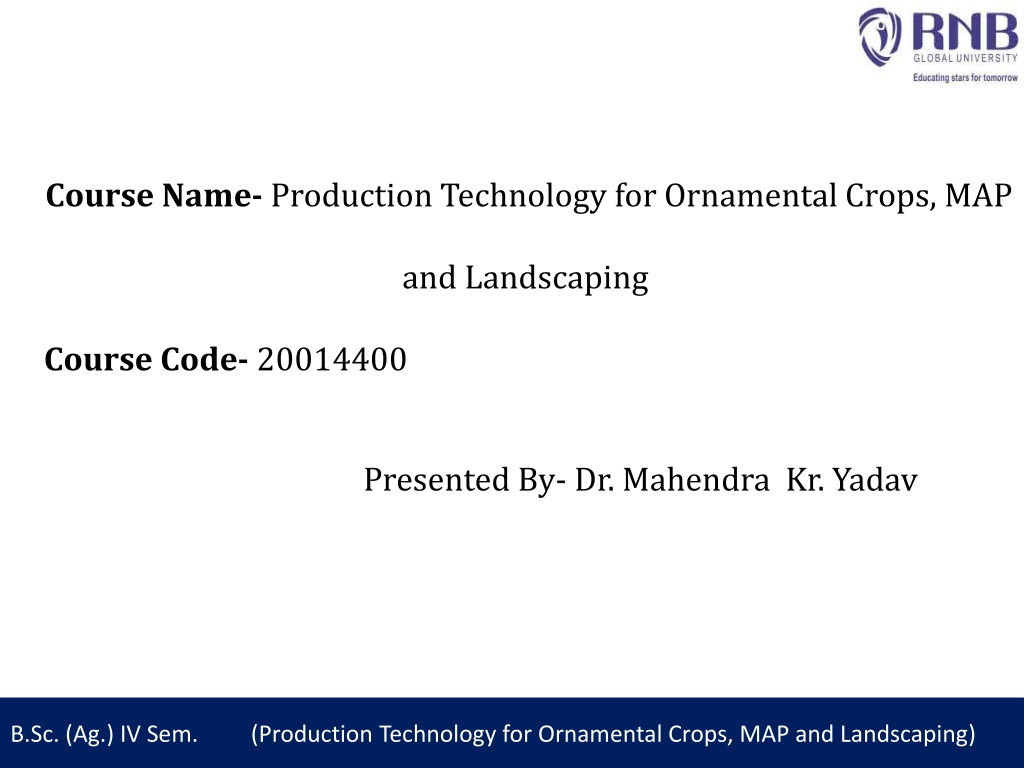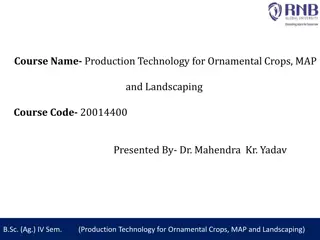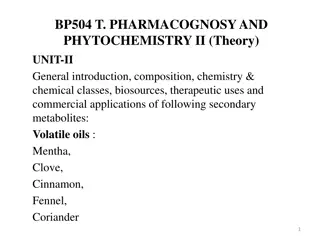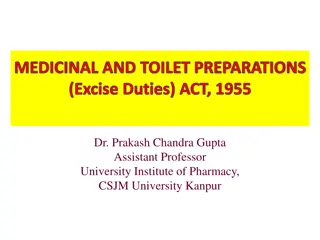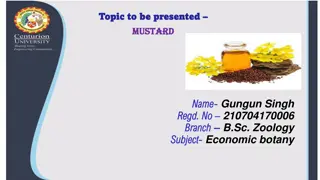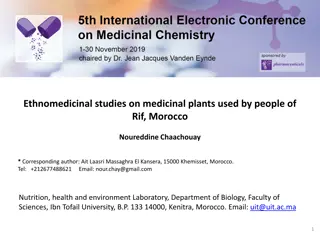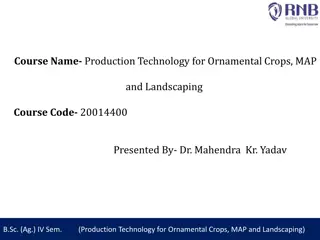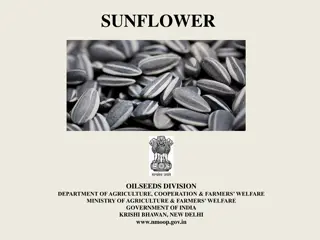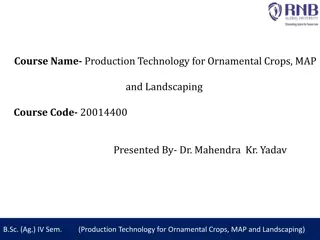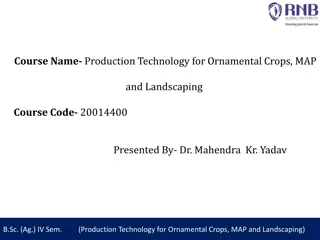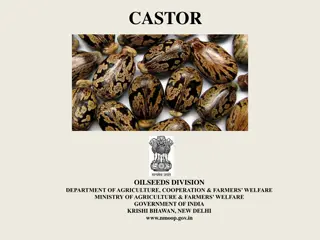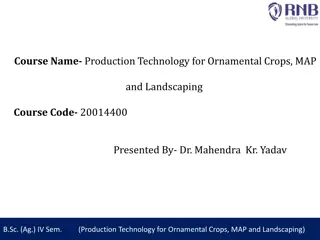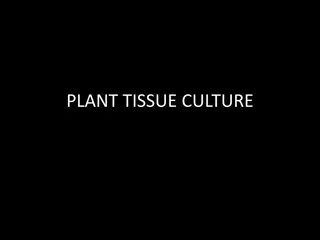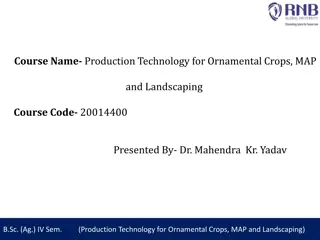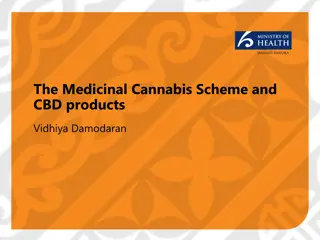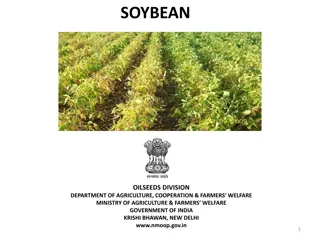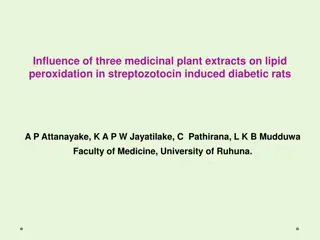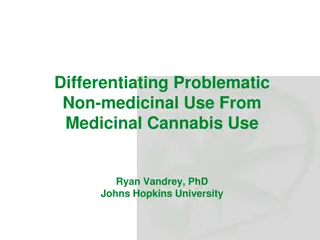Production Technology of Periwinkle - Medicinal Plant Cultivation Guide
Learn about the production technology of periwinkle, a perennial ornamental herb with medicinal properties. Understand its botanical details, uses in treating diseases, cultivation requirements such as soil and climate preferences, and its significance in pharmaceuticals. Discover the various alkaloids present in different parts of the plant and the importance of periwinkle in the agriculture sector.
Download Presentation

Please find below an Image/Link to download the presentation.
The content on the website is provided AS IS for your information and personal use only. It may not be sold, licensed, or shared on other websites without obtaining consent from the author. Download presentation by click this link. If you encounter any issues during the download, it is possible that the publisher has removed the file from their server.
E N D
Presentation Transcript
Course Name- Production Technology for Ornamental Crops, MAP and Landscaping Course Code- 20014400 Presented By- Dr. Mahendra Kr. Yadav B.Sc. (Ag.) IV Sem. (Production Technology for Ornamental Crops, MAP and Landscaping)
Course Objectives Identify different types of ornamental and medicinal crops. Examine various principles of landscaping, uses of landscape trees, shrubs and climbers, production technology of important ornamental crops, etc. Determine about Demonstrate various Package of practices for loose flowers and their transportation, storage house and required condition for cut and loose flower. Construct about the various problems with the production technology of medicinal and aromatic plants. Importance of Processing and value addition in ornamental crops and MAPs produce. B.Sc. (Ag.) IV Sem. (Production Technology for Ornamental Crops, MAP and Landscaping)
Production technology of periwinkle B.Sc. (Ag.) IV Sem. (Production Technology for Ornamental Crops, MAP and Landscaping)
Production technology of periwinkle Botanical Name : Catharanthus roseus Family : Apocyanaceae Chromosome No. : 2n = 34 Origin : Madagascar Plant Part use -Leaves, seeds, roots Uses Leaves used in curing blood cancer Leaves useful in treating menstrual disorders, diabetes mellitus. Decoction of leaves & roots active on hypertension. Roots control high blood pressure. B.Sc. (Ag.) IV Sem. (Production Technology for Ornamental Crops, MAP and Landscaping)
Importance: Periwinkle is a perennial ornamental herb found throughout India on waste lands and sandy tracts. It has medicinal importance owing to the presence of indole alkaloids raubasin (ajmalicine) and serpentine in its root which have anti-fibrillic and hypertensive properties. The leaves contain two alkaloids viz., Vinblastine and Vincristine which form the constituents of patented cancer drugs and vincristine alkaloids are distributed in different parts of the plant but the roots contain the maximum (0.75 t to 1.20%) followed by the leaf (0.60 to 0.65%). B.Sc. (Ag.) IV Sem. (Production Technology for Ornamental Crops, MAP and Landscaping)
Soil: It grows on any type of soil except those which are highly alkaline or waterlogged. It grows wild in coastal area. Light sandy soils rich in humus are preferred for large scale cultivation of the plant. Ph should be upto 8.5. Climate: The cosmopolitan distribution of the plant shows that it has no specific climatic requirements. Its natural environments are, however, tropical and sub- tropical areas. A well distributed rainfall of 100 cm or more is considered ideal for raising it as commercial crop under rainfed conditions. Varieties White flowered, Purple flowered and Nirmal (white flowered variety: from CIMAP) are the three types of periwinkle. Nirmal and Dhawal are the released cultivars of white flowered type. B.Sc. (Ag.) IV Sem. (Production Technology for Ornamental Crops, MAP and Landscaping)
Method of Propagation: Seeds. 1. Direct sowing method About 2 to 3 kg seed is required for raising one hectare. The seeds are mixed with sand about 10 times its weight for even distribution and are sown during beginning of monsoon. 2. Seedling Transplanting method Seed rate: 500 grams/ hectare. The seeds are sown in well prepared beds during March or April in rows about 1.5 cm deep, covered with light soil and leaf mould mixture and are watered to keep the bed moist. In about 10 days time the seeds germinate and in 2 months time (height 6-7 cm ) they become ready for transplanting. 200 square meters bed is required for producing seedlings for one hectare. B.Sc. (Ag.) IV Sem. (Production Technology for Ornamental Crops, MAP and Landscaping)
Planting Time: June - July or September - October. Spacing: Seedling are transplanted at a spacing of 45 cm x 30 cm or 45 cm x 45 cm. Weeding: The crop requires two weedings, the first one about 60 days after sowing or transplanting and the second one in another 60 days. B.Sc. (Ag.) IV Sem. (Production Technology for Ornamental Crops, MAP and Landscaping)
Manures and fertilizers Apply FYM at 20 t/ha and N, P and K at 25:50:75 kg/ha as basal dose. On 60 days after transplanting apply 50 kg N as top dressing. Irrigation The plant do not require much water as they have drought resistant capacity. In areas, where rainfall is evenly distributed throughout the year, no irrigation is required, but in areas where monsoon is restricted, 4 to 5 irrigations are required during the life of the plant to get good yield. B.Sc. (Ag.) IV Sem. (Production Technology for Ornamental Crops, MAP and Landscaping)
Yield : Yield (kg/ha) Plant part Irrigated Rainfed Roots 1500 kg/ha 750 kg/ha Stems 1500 kg/ha 1000 kg/ha Leaves 3000 kg/ha 2000 kg/ha B.Sc. (Ag.) IV Sem. (Production Technology for Ornamental Crops, MAP and Landscaping)
